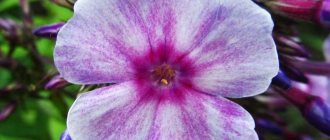The herbaceous plant Phlox Drummond belongs to the Sinyukhov family, which naturally grows in the south of America. Bright flowers were brought to Europe at the end of the 19th century, where they immediately began to be used to decorate English gardens. Phlox of this type can have different heights, so they can be planted not only in flower beds, but also used to decorate rock gardens, ridges, borders, and flower beds. To ensure long and abundant flowering, Drummond phlox is grown from seeds through seedlings. You can learn all the secrets of sowing, planting and caring for annuals in the garden from our article.
Phlox Drummond: growing seedlings
When to plant Phlox Drummond seeds? In order for phlox to bloom in June, the seeds need to be sown no later than April, and preferably earlier. How to properly plant seed material will be discussed further.
Growing Drummond phlox seedlings occurs in several stages:
- Phlox seeds can be sown in plastic containers with transparent lids. The seedlings will develop well in them. The microclimate there is like in a small greenhouse: warm and humid. At the bottom of the container, you need to drill holes with a hot awl and fill them with soil. You can germinate the seeds first - this will speed up the germination process.
- Before sowing, it is useful to first hold the seeds in a damp cloth. Seeds are sown in 2-3 pieces at a distance of 15 cm, deepening by 1.5 cm. Seedlings appear in a week. During the dive, weak plants are removed, leaving only one.
- To prepare the substrate, you need to mix the purchased flower soil and sand equally. The substrate does not need to be poured to the top of the container. It is necessary that 2 cm remain from the top layer of soil to the edge of the container. It is necessary to water so that the soil does not dry out, but there is no need to allow it to overflow, otherwise rotting of the horse system may occur.
- Every day you need to open the lid to ventilate the crops, make sure that there is no mold and condensation does not accumulate. You can sow phlox seeds in another suitable container and cover with film.
- After three true leaves appear, the seedlings are planted in separate pots or containers, divided into cells.
- After picking, it is advisable to feed the plant with complex mineral fertilizer for flowers.
- For bushiness, pinch 4-5 leaves.
How to plant Drummond phlox? Seedlings should be planted in the garden after the last frost. Typically at the end of May or beginning of June. When planting, the distance between plants should be from 15 to 20 cm.
At first, it is necessary to protect the plants from direct sunlight. Depending on the plant variety, it grows up to 25-60cm.
Landing location
Drummond phloxes bloom well in flower beds and mixed borders. It is advisable to plant them with spring flowers. When the primroses fade, the phloxes will cover the empty space with their lush blooms. It is useful to plant phlox near the porch or in a portable planter.
In cool climates, it is better to plant phlox in a well-lit, sunny place. In the southern regions, Drummond phlox is best grown in partial shade. In addition, in the south, plants can be insulated with non-woven material for the winter, and the next summer they will grow and bloom, only less abundantly.
On a note!!!
Despite the fact that the plant is cold-resistant and is not afraid of cool weather, it is advisable to plant it in a well-lit area with light shading.
The soil
Land for planting can be taken from the garden bed, adding a little river sand and peat to it. If the soil is acidic, you will have to add lime or ash. In sandy soil, plant roots can overheat in hot weather.
Moisture can stagnate in clay soil, which will lead to rotting of the roots. For the same reason, an area with high groundwater levels is not suitable for planting phlox.
Fertile and well-drained soil is ideal.
Diseases and pests
Succulent bushes that love watering serve as excellent food for slugs. If grapes or cabbage grow nearby, you can expect an invasion of these pests with a high degree of probability. To protect the flowerbed from slugs, sprinkle the soil with ash, tobacco dust, and fluff lime is also good. Treat against caterpillars together with other crops, using the same product as for them.
Phlox Smoky Coral
If the foliage on the phlox has turned yellow and started to fall off, the most likely reason for this is drought. Plants lack moisture. Watering must be increased, otherwise all the bushes will die.
Advice! In special cases, when the heat is too intense and there is no rain at all, abundant spraying with water, which is carried out in the early morning or at sunset, is of great benefit.
From May to June, traces of vertical cracking of the stems can be found on individual bushes. After healing, the crack becomes covered with a characteristic influx (callus). The stem itself becomes rougher and more fragile. In strong winds, such bushes may even break. The main reason for this phenomenon is the increased concentration of nitrogen in the soil, as well as too much acidity. This is corrected by liming.
Phlox pests
When affected by viral infections, the size of flowers changes and they usually become smaller. It is even possible that various ugly mutations may appear. Unfortunately, there is no treatment. There is only one way out - to completely destroy the affected bushes. Typical viruses unique to phlox have not yet been identified. They are susceptible to infection from neighboring garden crops.
Fungi penetrate plants through microscopic wounds: cracks on leaves, scratches on stems. Under favorable conditions (damp and cool), the mycelium grows very quickly. This process is accompanied by the appearance of spots on the leaves and the appearance of dried areas. For many fungal diseases, our own preparations have been developed; usually, spraying with Bordeaux mixture is used as an effective measure.
By following all agrotechnical rules, you can enjoy bright flowering for a long time.
0 0 votes
Article rating
Phlox annual: seeds
If you cut off all the faded inflorescences in time, the bushes will quickly grow new shoots, which will also have time to bloom. Phlox can bloom until cold weather persists.
After flowering, phlox set numerous seeds. When the seed shell becomes yellowish, you need to cut off the inflorescence on a sunny day and put them in a box with a loose lid. Keep the box in a warm, dry place. In the box, the twigs with seeds are completely dry. And next year, such seeds can be used to plant Drummond phlox.
Use in the garden
Drummond phloxes have several uses in the garden:
- Low varieties of phlox are used for borders, flower beds, they can be used for planting in containers that decorate terraces and balconies.
- Higher varieties are grown in groups in flower beds.
- High varieties are used for cutting into bouquets. The flowers are cut off when the first flowers in the inflorescence open. They remain fresh in a vase for 10-14 days.
By mixing phlox varieties of different colors, you can create a charming border with a rustic character. An additional advantage of this type of phlox is the delicate aroma of flowers.
Phlox drummondi looks beautiful in large, dense clumps in village gardens, especially when combined with stately plants such as mallow, loosestrife and mullein, as well as slightly shorter zinnias and a variety of dahlias.
Sowing seeds in autumn
Drummond phlox seeds can withstand low temperatures. Only the seeds need to be sown on time. If sown early, the seeds will germinate and then die from frost. They need to be sown when the last leaves fall from the cherry tree.
In any case, it is better to cover the crops with non-woven material. In the southern regions, seeds can be sown even in February. After a snowfall, rows are made in which the seeds are placed. The plantings are covered with fertile soil and covered with a 20 cm layer of snow. Until warm days, the seeds will remain dormant. Sprouts will appear in April.
Reproduction methods
Drummond Phlox can be propagated in two ways:
- seedlings grown in advance on the windowsill;
Young leaves of hatched plants are vulnerable to direct sunlight. They should not be placed on the windowsill to avoid burns. - seeds, which are placed immediately in open ground.
It is impossible to obtain high-quality seeds at home from F1 hybrids or tetraploid varieties, since they do not retain parental characteristics
The second option is the most preferable, as it makes life much easier for gardeners. When sowing seeds, there is no need to care for the seedlings and subsequently replant them. In addition, seedling propagation will require seed stratification, which can be avoided when planting in open ground.
Phlox Drummond: varieties
Phlox Drummond belongs to the Phlox species and the Sinyukhov family. A very popular garden plant. And there are a huge number of popular varieties. Among them are the following:
Phlox drummond Strawberry and cream
The flowers are mahogany with a bright and juicy color of red and white. The bushes are compact, reaching a height of 25 cm. Flowering is abundant. The flower size is 3 cm in diameter. The flowers are collected in corymbose inflorescences. Flowering period from late June to October.
Phlox Drummond Star Rain
Its small flowers look like stars. The plant reaches a height of 50 cm, the colors are very different: red, white, blue, purple, pink, etc. There are flowers with a white border around the edge, with a white stripe in the middle, or with a white center. Unpretentious in care. They bloom from June until frost. It should be grown in an open sunny area.
Phlox Drummond Buttons
The plant is not tall. It reaches a height of 25 cm. The flowers are two-color, flat. In the middle is one color, and around the edges is another. Blooms profusely until frost. Unpretentious. Suitable for decorating flower beds and ridges. Biennial.
Phlox Drummond Charm
Similar to Buttons variety. Annual. The bush is lush and branched. The flowers are collected in flat corymbose inflorescences. Blooms until late autumn. It is highly decorative. It is best to grow flowers in seedlings. Seeds are sown in April, seedlings are planted in the soil at the end of May.
Phlox Drummond Grandiflora
The plant grows up to 35 cm in height. It branches strongly from the stem. Flowers are 2-2.5 cm in diameter. The colors are very varied. Flowers are collected in thyroid inflorescences. The plant is not afraid of rain and minor frosts. Light- and heat-loving. Relatively drought-resistant. In order for phlox to bloom well, timely watering and removal of wilted inflorescences are required.
Phlox Drummond Tetra Riesen
The flowers are large, up to 4 cm in diameter, and have various shades of blue and white. Cold resistant. They have a wide variety of shades. Grows up to 40 cm. Flowering profusely. They can decorate any flower bed. They look good on the porch and along the walls, in the flower bed.
Phlox Drummond Tapestry
It is also called elegant phlox. Flowers of a wide variety of colors. The variety tolerates winter frosts well. This variety, like the others, blooms until frost. Propagated by seeds. Shoots can be seen on the 15th day. It is planted in the ground according to a 20x30 cm pattern. In order for the plant to bloom profusely, it should be fed regularly.
Phlox Drummond Art shades
Low growing variety. The bush is lush and highly branched, usually growing up to 45 cm in height. The flowers are collected in an umbrella-shaped inflorescence. The coloring is varied. White stripes similar to spider legs extend from the center. The variety is highly decorative. It shows its beauty best in fertile soil and sunny areas.
Drummond phlox bushes will decorate any corner of the garden; they do not require special care.
Description of the flower
The calyxes of the flowers are divided into five parts, the flowers are round in shape with five petals on the corolla. The corolla of phlox drummond can be colored red, pink, cream, purple.
For your information! The plant feels good both in the sun and in the shade. Drummond phlox requires abundant watering, but due to excess moisture it stops blooming. Early frosts (not lower than −5 °C) are dangerous only for flowers.
How does this variety of phlox bloom?
Varieties of phlox drummond are divided into two numerous types - large-flowered (grow up to 45 cm in height, bloom with large flowers) and dwarf plants (10-20 cm in height).











